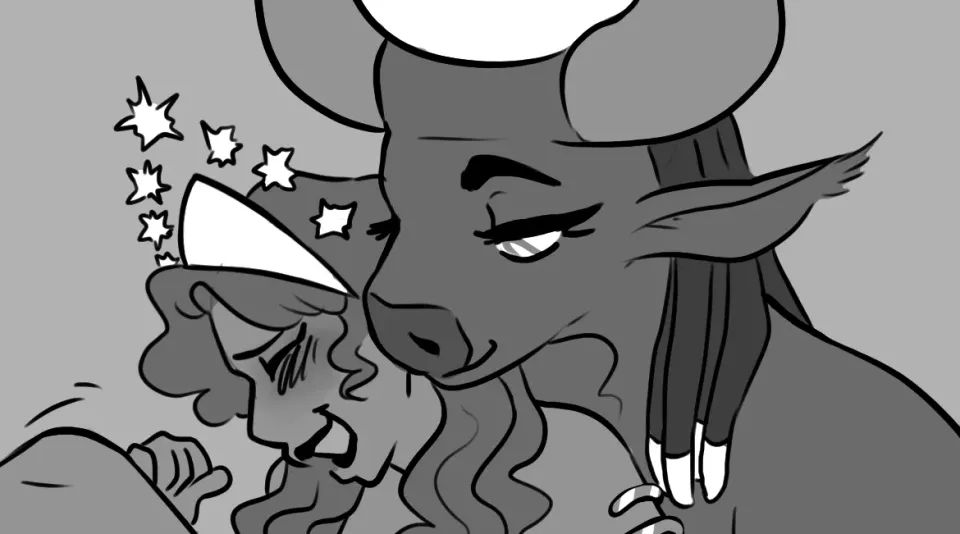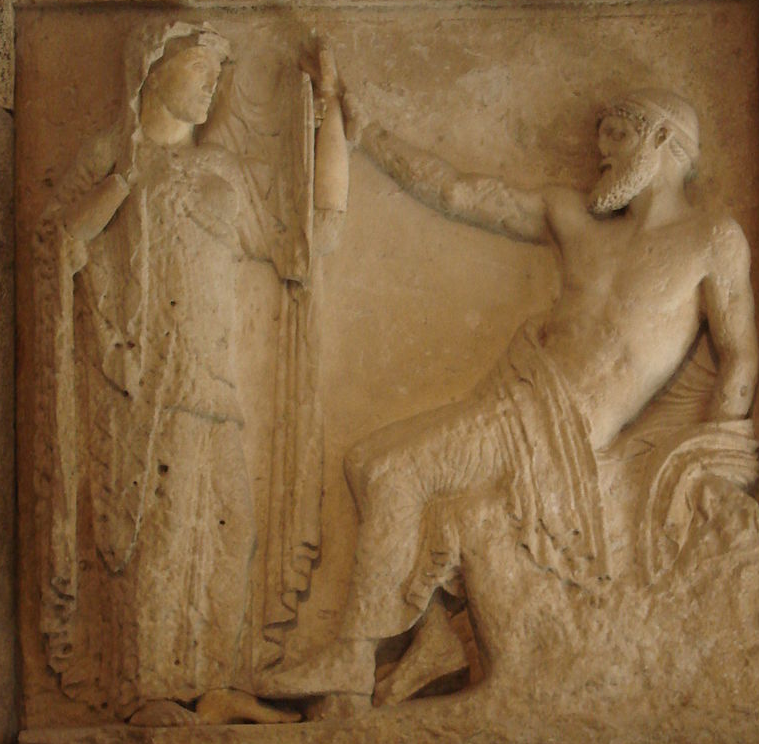Illustrated Fiction: Queen of Happiness (Hathor x Ariadne)

Hello my lovely demigoddesses and demigods,
this piece has been finished since the start of August but it took me forger to edit because of a heatwave that had large parts of Europe in its thrall until last weekend. I need a clear head when editing and when it's hot even at night (when I work best), I have a hard time focusing 😣
I have long finished the Ares x Aphrodite story too and started editing but I chose to prioritise Hathor and Ariadne. I'm also submitting a Charmes fanfic to the Hades game beach fanzine this month and I'll share it with y'all once I can, three weeks after the zine is published in mid-September.
As a little surprise, it was SiggyKuu who jumped in for Mandy to do this month's illustration. I hope you love her muscle mummy Hathor and expressive Ariadne as much as I and Dionysos do!
SiggyKuu has a Patreon and you should check out her myth-themed comic Evoe over at Tapas!
Glossary
Asterion: the given name of the Minotauros is Asterion or Asterios, latinised to Asterius.
Bacchae: the female attendants or priestesses of Bacchus or Bakkhos, another name of Dionysos.
Dendera: Cult centre of Hathor, who is the patron deity of the city. The ancient Egyptian name is ı͗wnt-tꜣ-ntrt, "the city Iunt of the goddess" (Hathor). The Greeks call the place Tentyris, probably after the latter part of the Egyptian name.
Great Green: ancient Egyptian name for the Mediterranean Sea.
Hathor: She is the goddess of music, dance, joy, beauty, love, sexuality and motherhood. The ancient Egyptians connected her with foreign lands such as Nubia and Canaan and their valuable goods, such as incense and semiprecious stones. As the Eye of Ra, she had a vengeful aspect that protected him from his enemies. Ra sent Hathor as the Eye of Ra to punish humans for plotting rebellion against his rule. As the lioness goddess Sekhmet she massacred the humans, but to stop her from killing all humanity, Ra had beer dyed red and poured out over the land. Sekhmet drank the beer, mistaking it for blood, and in her inebriated state reverted back to the benign Hathor. This event was commemorated every year by the ancient Egyptians with the Festival of Drunkenness.
Iunt: ancient Egyptian name for Dendera, a cult centre of Hathor where she is the patron deity of the city.
Ka: The ancient Egyptians believed that a soul was made up of many parts. The ka is one of those parts, the vital essence. When a person is born, ka is breathed into them and when the person dies, their ka leaves the body. The ka is sustained with food and drink, hence the words ‘for your ka’ are associated with offering alcohol.
Kaftu: ancient Egyptian name for Crete.
kantharos: a type of ancient Greek cup used for drinking, especially wine drinking, that is a common attribute of Dionysos and his retinue. It looks like this.
Keftiu: ancient Egyptian name for the Minoan and Mycenean Greek civilisations.
keles: horseback racing as a discipline at the ancient Olympics
Kunuša / Kunusha: ancient Egyptian name for Knossos, the home of Ariadne and Asterion on the island of Crete.
seistron: ancient Greek word, lit. "that which is being shaken", for an ancient Egyptian percussion instrument that was used particularly in the worship of Hathor. It looks like this.
Tekh Festival: Tekh is ancient Egyptian for "Drunkenness" and the name of their first month of the year (August in our calendar, marked by the flooding of the Nile), so the Tekh Festival is the Festival of Drunkenness, celebrating Hathor and the time that humanity was saved from destruction with the use of beer.
thyrsos: a staff of giant fennel decorated with vine, ivy, and ribbons and topped with a pine cone. The thyrsos is carried by Dionysos and his retinue, especially maenads.
tribas: the word usually refers to a woman who has sex with other women but it is a "masculine" woman taking the active, "male" part during sex, penetrating her partner.
The title references one of Hathor's epithets: "At Dendera, Hathor is ‘mistress of the dance, queen of happiness’." (Quoted from Dancing for Hathor by Carolyn Graves Brown)



